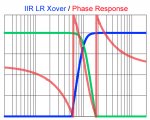Re: FIR filters
Are we talking about the same thing? I was thinking of this link that he posted earlier in the discussion, not today's post.
http://www.fulcrum-acoustic.com/ass...ogram-loudspeaker-transient-response-2005.pdf
This it not what Bennett is saying.
- Any transient involves a wide range of frequency components (lows and highs) that must align with each other in a specific phase relationship to sum together in a way that gives rise to the rapid upward slope when viewing the amplitude versus time (i.e. like how your DAW displays a snare hit during a mix session).
- If you scramble the phase relationship between the various frequency components, the energy is still there at each frequency, but the arrivals are no longer coherently combining to give the rapid rise on the amplitude vs. time display. The net result is that the energy content is the same, but the peak amplitude of the signal is reduced.
- Since loudspeakers, which by their nature are bandpass devices that exist in a causal (i.e. time goes forward) universe, a loudspeaker is always going to alter the phase relationships of what comes out of it.
- We can quantify this alteration, and pre-warp the phase of the original signal to counteract the loudspeaker so that the loudspeaker's inherent limitations serve to re-align the phase back to the original desired signal.
- A side effect of the pre-warping on highly organized signals like transients is that the peak amplitude of the signal is usually reduced after pre-warping.
- Since amplifiers are usually constrained at high frequencies not by their ability to supply energy, but rather in their maximum voltage swing (i.e. amplitude), reducing the amplitude of the signal peak by pre-warping serves to open up some breathing room on the amplifier voltage swing, and therefore allows more possible peak output from an amplifier with a given voltage swing capability.
Are we talking about the same thing? I was thinking of this link that he posted earlier in the discussion, not today's post.
http://www.fulcrum-acoustic.com/ass...ogram-loudspeaker-transient-response-2005.pdf

